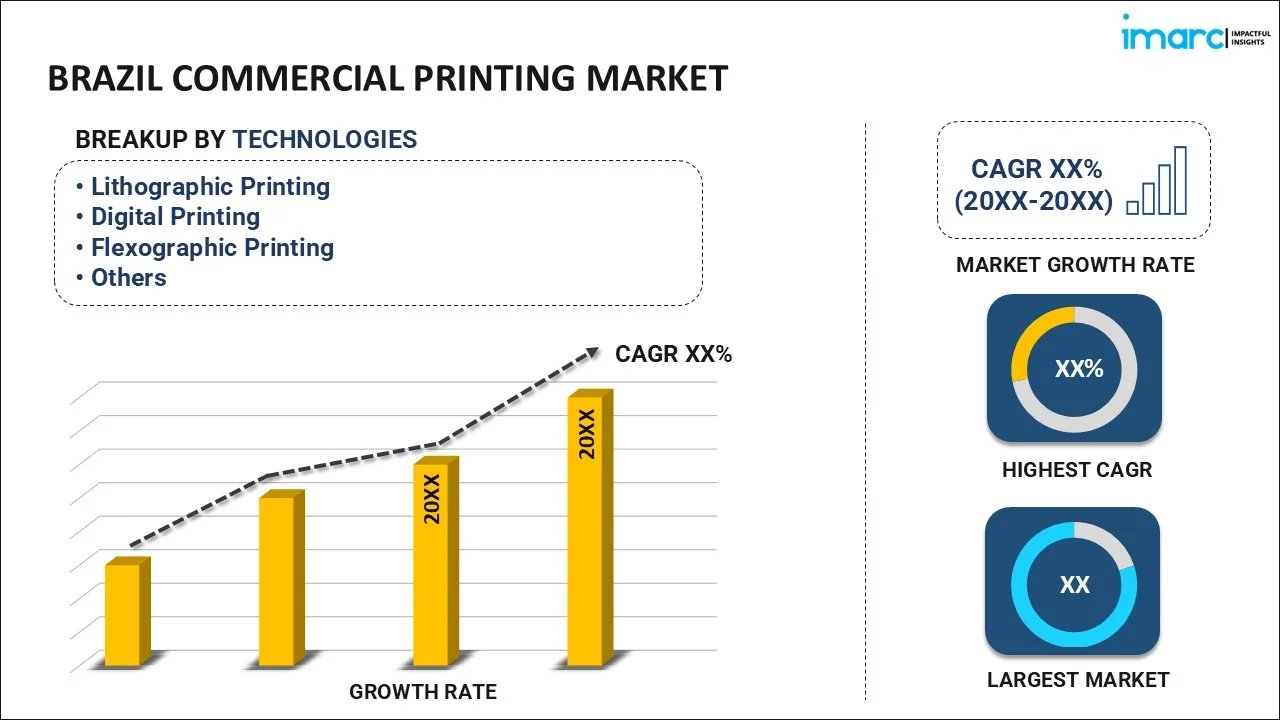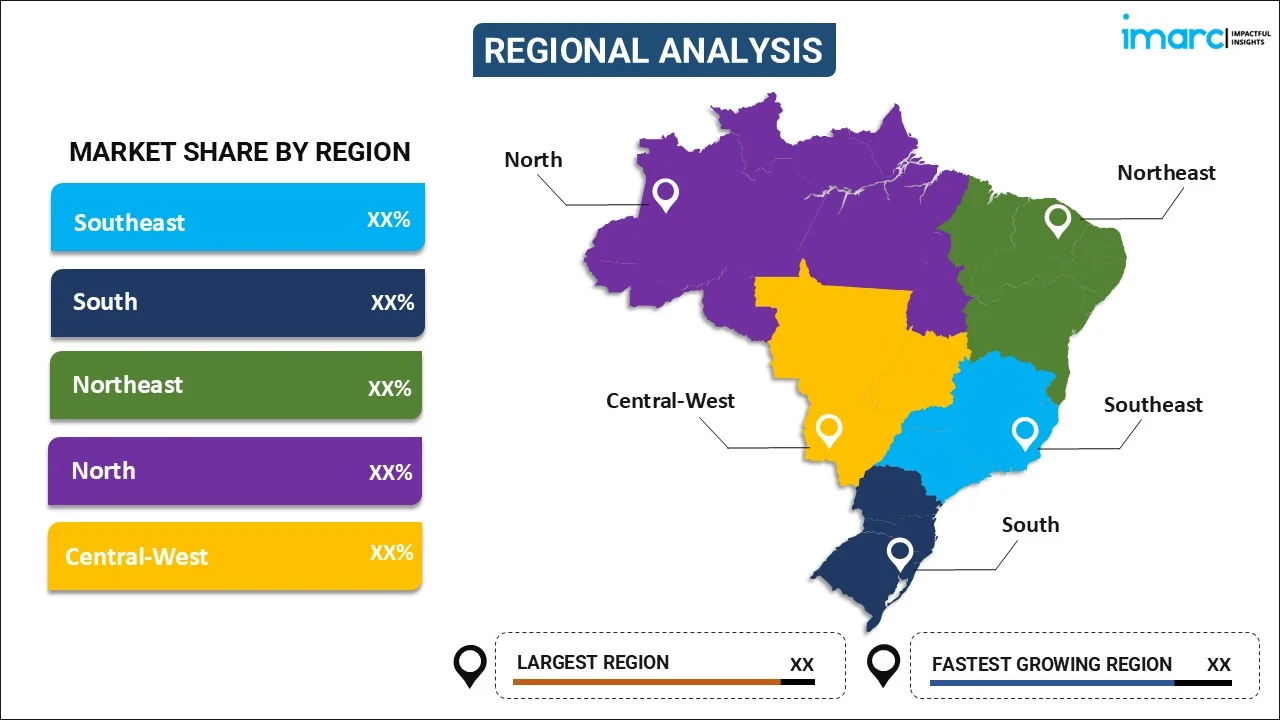
Brazil Commercial Printing Market Size, Share, Trends and Forecast by Technology, Print Type, Application, and Region, 2026-2034
Brazil Commercial Printing Market Overview:
The Brazil commercial printing market size reached USD 10.5 Billion in 2025. Looking forward, IMARC Group expects the market to reach USD 14.0 Billion by 2034, exhibiting a growth rate (CAGR) of 3.33% during 2026-2034. Factors influencing the Brazil commercial printing sector consist of rising industrial needs for printed goods such as packaging, labels, and promotional items, technological innovations like Industry 4.0 incorporation in printing equipment, and the drive for digital transformation in Brazilian industries, coupled with heightened consumer demand for personalized and eco-friendly print options.
|
Report Attribute
|
Key Statistics
|
|---|---|
|
Base Year
|
2025
|
|
Forecast Years
|
2026-2034
|
|
Historical Years
|
2020-2025
|
| Market Size in 2025 | USD 10.5 Billion |
| Market Forecast in 2034 | USD 14.0 Billion |
| Market Growth Rate (2026-2034) | 3.33% |
Brazil Commercial Printing Market Trends:
Economic Growth and Industrial Expansion
Brazil's economic development has a major effect on the commercial print industry. From 2000 to 2022, the Gross Value Added (GVA) in the nation expanded by 58.2%, with an average growth of 2.1% per annum. This was mainly fueled by the growth of the employed population, which contributed 46.5 percentage points. Industrial activity growth causes greater demand for printed items like packaging, promotional items, and product labels. As businesses grow, they need more printed goods to sustain their operations and sales activities. In addition, the efforts of the Brazilian government to enhance industrialization and infrastructure growth also encourage the consumption of commercial printing activities. For example, "New Industry Brazil" (Nova Indústria Brasil) is a program that seeks to digitally renew 25% of Brazilian industrial firms by 2026 and expand this aim to 50% by 2033. Such digitalization is anticipated to accelerate the demand for printed items across different industries. With the growth of the industrial base in Brazil, demand for printed items in these sectors also expands. With production quantities of consumer and manufacturing goods expanding, requirements for packaging, labels, and marketing materials grow increasingly important. Packaging, for example, takes the lead position across the food, beverages, cosmetics, and electronic industries. Businesses within these sectors need high-quality, specialized packaging that fulfills customer expectations and legislative requirements, thereby fueling the demand for commercial printing.
Significant Technological Advancements and Digital Transformation
Technological innovations are transforming the business printing sector in Brazil. Integration of digital print technologies has supported faster turnaround, increased personalization, and cost savings. The change enables enterprises to address increased demand for individualized and small-run printed goods. The efforts of the Government of Brazil toward digitalization, such as with the "New Industry Brazil" program, support this trend. The emphasis of the program on digitizing industrial enterprises is likely to propel innovation and efficiency in the printing industry. The private sector is expected to invest BRL 85.7 billion by 2035 in machinery, infrastructure, research and development, and new industrial facilities, including investments in emerging printing technologies. Additionally, the use of digital technologies by the printing industry is consistent with international trends toward sustainability and green practices. Digital printing minimizes waste and energy usage relative to conventional processes, which attracts green consumers and enterprises. Overall, Brazil's industrial growth and economic development, technological innovation, and digitalization strategies are central drivers of the commercial printing industry. These factors all work together to create the development of the sector and its capacity to serve the various needs of an expanding economy.
Brazil Commercial Printing Market Segmentation:
IMARC Group provides an analysis of the key trends in each segment of the market, along with forecasts at the region/country level for 2026-2034. Our report has categorized the market based on technology, print type, and application.
Technology Insights:

- Lithographic Printing
- Digital Printing
- Flexographic Printing
- Screen Printing
- Gravure Printing
- Others
The report has provided a detailed breakup and analysis of the market based on technology. This includes lithographic printing, digital printing, flexographic printing, screen printing, gravure printing, and others.
Print Type Insights:
- Image
- Painting
- Pattern
- Others
A detailed breakup and analysis of the market based on the print type have also been provided in the report. This includes image, painting, pattern, and others.
Application Insights:
- Packaging
- Advertising
- Publishing
A detailed breakup and analysis of the market based on the application have also been provided in the report. This includes packaging, advertising, and publishing.
Regional Insights:

- Southeast
- South
- Northeast
- North
- Central-West
The report has also provided a comprehensive analysis of all the major regional markets, which include Southeast, South, Northeast, North, and Central-West.
Competitive Landscape:
The market research report has also provided a comprehensive analysis of the competitive landscape. Competitive analysis such as market structure, key player positioning, top winning strategies, competitive dashboard, and company evaluation quadrant has been covered in the report. Also, detailed profiles of all major companies have been provided.
Brazil Commercial Printing Market News:
- February 2025: Agfa, a top firm in inkjet printing technologies, is to present its newest innovations at FESPA Brasil 2025, providing an extensive array of advanced inkjet solutions for different printing needs. The company seeks to assist sign & display, packaging, and industrial printing firms in producing top-notch, efficient prints, reflecting a dedication to ongoing innovation.
- September 2023: Etirama introduced its latest SPS3 flexo press at Labelexpo Europe 2023, showcasing Industry 4.0 connectivity, extensive customization options, and the capability to operate at speeds reaching 150m/min. The SPS3 press is adaptable and capable of handling self-adhesive materials, lightweight cardboard, paper substrates, and unsupported films for diverse label creation, and it's also appropriate for printing aluminum blister packs.
- October 2023: Heidelberg has introduced a revised Versafire EV and EP model of digital presses, designed for autonomous operation and compatibility with hybrid workflows, which is able to print banners as long as 1,260 mm and accommodate substrates ranging from 40 gsm to 470 gsm.
Brazil Commercial Printing Market Report Coverage:
| Report Features | Details |
|---|---|
| Base Year of the Analysis | 2025 |
| Historical Period | 2020-2025 |
| Forecast Period | 2026-2034 |
| Units | Billion USD |
| Scope of the Report |
Exploration of Historical Trends and Market Outlook, Industry Catalysts and Challenges, Segment-Wise Historical and Future Market Assessment:
|
| Technologies Covered | Lithographic Printing, Digital Printing, Flexographic Printing, Screen Printing, Gravure Printing, Others |
| Print Types Covered | Image, Painting, Pattern, Others |
| Applications Covered | Packaging, Advertising, Publishing |
| Regions Covered | Southeast, South, Northeast, North, Central-West |
| Customization Scope | 10% Free Customization |
| Post-Sale Analyst Support | 10-12 Weeks |
| Delivery Format | PDF and Excel through Email (We can also provide the editable version of the report in PPT/Word format on special request) |
Key Benefits for Stakeholders:
- IMARC’s industry report offers a comprehensive quantitative analysis of various market segments, historical and current market trends, market forecasts, and dynamics of the Brazil commercial printing market from 2020-2034.
- The research report provides the latest information on the market drivers, challenges, and opportunities in the Brazil commercial printing market.
- Porter's five forces analysis assist stakeholders in assessing the impact of new entrants, competitive rivalry, supplier power, buyer power, and the threat of substitution. It helps stakeholders to analyze the level of competition within the Brazil commercial printing industry and its attractiveness.
- Competitive landscape allows stakeholders to understand their competitive environment and provides an insight into the current positions of key players in the market.
Key Questions Answered in This Report
The commercial printing market in Brazil was valued at USD 10.5 Billion in 2025.
The Brazil commercial printing market is projected to exhibit a CAGR of 3.33% during 2026-2034, reaching a value of USD 14.0 Billion by 2034.
The market is driven by the expansion of the advertising sector, demand for packaging across food and consumer goods industries, growth in e-commerce, and the need for high-quality, short-run print jobs. Technological advancements in digital printing and customized print solutions further support market growth, alongside rising demand from education, retail, and publishing sectors.
Need more help?
- Speak to our experienced analysts for insights on the current market scenarios.
- Include additional segments and countries to customize the report as per your requirement.
- Gain an unparalleled competitive advantage in your domain by understanding how to utilize the report and positively impacting your operations and revenue.
- For further assistance, please connect with our analysts.
 Request Customization
Request Customization
 Speak to an Analyst
Speak to an Analyst
 Request Brochure
Request Brochure
 Inquire Before Buying
Inquire Before Buying




.webp)




.webp)












